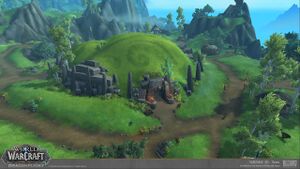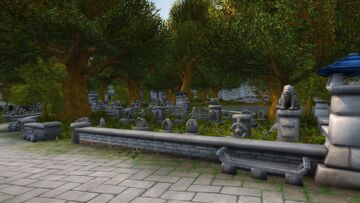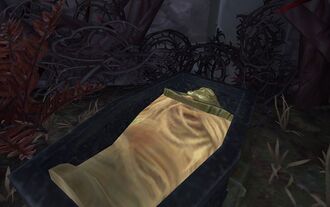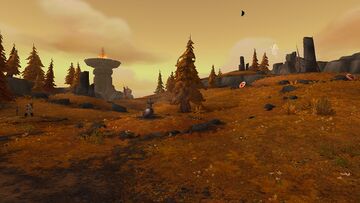Funerary practices
- This article is about cultural practices related to death. For the burial ground, see Graveyard. For Death as a cosmic force, see Death.
Funerals are ceremonies performed to honor the remains of a deceased. On Azeroth and beyond, each race has its own funeral rites according to their culture and beliefs, whether by burials, cremations, mummifications, or other processes. Even after the war against the Jailer, death is still an uncertainty to most citizens of Azeroth, as they didn't come to the Shadowlands with the adventurers, and not everyone came back from the realm of the dead.[1]
Practices by races
Ankoan
Ankoan believe the spirits of their ancestors continue to watch over them after death.[2] To honor their dead, the ankoan place wooden burial shrines over their graves. However, the names of those who have died a dishonorable or cowardly death are purposefully forgotten.[3]
Arakkoa
In death, all arakkoa seek to join Rukhmar in the skies above Draenor, and thus cremation is vastly preferred to burial. Some have their ashes scattered high in the skies, others are collected in ornate urns and placed in crypts.[4] While devotees of Rukhmar prefer cremation, the Arakkoa Outcasts have taken to darker last rites.[5]
Centaur
The Maruuk Centaur bury their dead in burial mounds called kurgans.[6] They also practice cremation.[7] They believe that the spirits of dead centaur live with Ohn'ahra in the sky and run alongside her on the winds.[8][9] When a mystic of Clan Ohn'ir dies, a sacred ohuna known as a Child of Ohn'ahra carries their spirit to Windsong Rise, where they may become one with the wind and sky.[10]
In Kalimdor, Maraudon is a combination of ancient centaur burial grounds, as well as a primal temple dedicated to the elemental earth.
Draenei

Before the destruction of Draenor, the draenei dead were entombed within Auchindoun and watched over by the Auchenai order. Since as far back as when they lived on Argus, souls of great eredar and draenei heroes have been installed in mechanical guardians called vigilants to aid their people after death.
Dragons
When dragons near the end of their lives, they fly to the Dragon Wastes in the center of the Dragonblight in Northrend to die and enrich the land with their passing.[11][12] The reason they fly specifically to the Dragonblight is possibly because it is the site of Wyrmrest Temple and the Chamber of Aspects, where the Dragon Aspects were allegedly empowered by the Pantheon.[11] Many choose to set their bodies close to the resting place of Galakrond, since he is (incorrectly) believed to have been the progenitor of dragons.[13]
According to Senegos, there was a time dragons would be laid to rest in Veiled Ossuary,[14] and the blue dragonflight claimed a small location there. Senegos was the last grave keeper after Neltharion's betrayal as the Dragon Isles were sealed away, and no one could be laid to rest there any longer.[15] The peaceful passing of a blue dragon is seemly to be uniting with the ley lines.[16]
Dwarves
Bronzebeard dwarves prefer to bury their dead, returning them to the ground that so benefits their race. They consider it both an honor and a repayment.[17] Some dwarves seal their deceased in tombs, but those with a concern about the undead might prefer cremation.[18]
The Wildhammers of the Twilight Highlands honor their dead heroes in Kirthaven before burying them with their gryphons atop Thunderstrike Mountain.
Gnolls
It is common tradition that when a gnoll dies, the members of his/her clan devour the body.[19]
Goblins
Status is supreme in goblin society, which is reflected in their funeral practices; the higher the deceased's status, the larger and more extravagant the funeral. Tradition dictates that goblins be buried with their most valuable possessions so they can enjoy them at the Everlasting Party, the goblin afterlife. The reading of the list of assets that belonged to the deceased in life serves as the highlight of the event. All of this is performed in full view of the deceased's family and rivals in order to inspire feelings of jealousy.
The only thing more important than being buried with one's possessions is the burial gifts bequeathed to the dead by other goblins, which serve as a reflection of wealth and social standing and consist of everything from coins, pearls, furniture, and clothing to weapons, food, and alcohol. In at least some cases, the goblin can draft a list of burial gifts they demand from the attendees. Wealthy funeralgoers bring their gifts in chests or butler-pushed wheelbarrows that they then empty into the coffin (which can consist of a simple metal container hammered into a funerary shape).
After the gifting ends, the attendees dance on top of the coffin to usher the deceased on to the Everlasting Party before lowering it into a hole at a burial site. Prominent goblins serve as pallbearers at the head of the coffin, while goblins contractually obligated to serve as pack mules carry the rear. The burial is followed by partying and feasting; it's common knowledge that a goblin funeral is nothing more than an excuse to throw a party with someone else footing the bill. As was the case with Trade Prince Donais, the goblin can pick out the musicians and refreshments that will be present at their funeral.[20][21]
Humans
Most humans follow the teachings of the Church of the Holy Light, which includes burying the deceased in cemeteries. Following the end of wars, the Church organizes ceremonies for the fallen,[22] taking care of preparing the bodies to be buried according to the traditions.[23] It is tradition that a small memento be buried on top of a Gilnean's graveyard, beneath the shallow earth.[24] The humans of Stranglethorn Vale have a tradition where they carefully remove weapons from a corpse before burial. They consider that a soul cannot rest if they carry the cause of their death with them forever.[25] Since the rise of the Scourge, some humans like Danath Trollbane prefer to be cremated, as they don't want to be raised as undead.[26]
For the most part, the humans of Kul Tiras do not bury their dead, but rather send them to the sea. The tidesages use an ornate bell named a Dead Ringer[27] that calls the souls of the recently deceased to them, and release them through the "Ritual of Release".[28] The souls of the fallen are released into rivers that flow through the Shrine of the Storm and out into the open sea. Legends say that as their spirits pass through the Shrine, they aid in the great blessing rituals that all Kul Tiran ships undergo. In that way, they never stop serving their people.[29] Mourners traditionally release ![]() [Star Moss], a magical flower notable for its sensitivity to feelings of loss, into the ocean during funerals.[30][31] Despite this, there is a large cemetery in Drustvar, indicating that the region has a different tradition and does bury their dead.
[Star Moss], a magical flower notable for its sensitivity to feelings of loss, into the ocean during funerals.[30][31] Despite this, there is a large cemetery in Drustvar, indicating that the region has a different tradition and does bury their dead.
Jinyu
Jinyu pray over heirlooms or tokens of their dead in order to properly lay them to rest, and move on.[32]
Magnataur
The Dens of Dying are a sacred place to the magnataur, where they go in their old age to die.[33]
Mogu
The rituals for desecrating a fallen opponent are a well-established part of mogu culture.[34] They also mummify their dead.[35]
The mogu view their dead as a collection of parts. Souls could be bound to stone for later use. Flesh and blood could be reforged to extend the lives of those loyal to the emperor. To be buried intact was a symbol of great power and respect. The Valley of Emperors serves as the resting grounds for a hundred generations of warlords, kings, and emperors who once ruled Pandaria.[36]
Night elves
Night elf burial is done naturally, returning the deceased to nature.[37] Priestesses begin by ritualistically cleansing the body in a moonwell, and they use nature and arcane magic to mend the body for a final viewing. The priestesses sing arias from their temples highlighting the deceased's life, after which the remains are placed on a flower-draped bier, carried to a grove, and placed on a patch of grass. A druid then spurs on the growth of plants around the corpse, creating a wide spectrum of colorful blooms which surround and then entirely encase the body.[38] They believe that when the valiant die, Elune sends them riding across the sky as stars.[39] Upon death they turn into wisps.
Ogres
Ogres use burial grounds.[40]
Orcs
Back before their corruption by the Burning Legion, orcs generally used to burn their dead on funeral pyres. Being laid to rest in the ground was an odd concept to them,[41] for they wanted their bodies to be given to fire, their ashes to air, to be consumed by water and earth, while their spirits would be then left free to join their ancestors.[42] That old custom was gradually abandoned as the orcs fell to their bloodlust and rejected their old shamanistic ways.[43] In present days some orcs are still being burned on funeral pyres, but others are now also laid to rest in graveyards. The Shadowmoon Burial Grounds on Draenor contained many of the Shadowmoon clan's dead.
Pandaren
A traditional pandaren funeral ceremony involves the lighting of the "Incense of Life",[44] which not only has a pleasant smell, but also has restorative properties and can even help plants grow. The incense is made from strongly aromatic spices, which gives it its unique scent, as well as blue crab shells.[45]
Taunka
Taunka bury their dead in burial grounds.[46]
Tauren
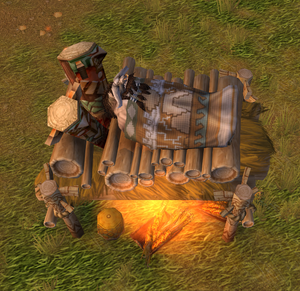
Tauren do not bury their dead, they prepare the body for its return to the elements by performing the traditional rites with a ![]() [Funerary Totem] and place it at their sacred grave sites.[47] The most valiant tauren are laid to rest at the sacred burial ground of Red Rocks. It is an honor bestowed upon the great warriors who helped found and defend Thunder Bluff and those who have given their lives for the greater good of their tribes and chieftains.[48]
[Funerary Totem] and place it at their sacred grave sites.[47] The most valiant tauren are laid to rest at the sacred burial ground of Red Rocks. It is an honor bestowed upon the great warriors who helped found and defend Thunder Bluff and those who have given their lives for the greater good of their tribes and chieftains.[48]
Highmountain tauren have sacred burial grounds.[49][50]
Tol'vir
Tol'vir mummify their dead.[51][52]
Trolls
When a troll of the Darkspear tribe dies, they get cremated on a ritual pyre and their ashes are stored within an urn.[53] The Zandalari trolls used to bury their dead in burial mounds[54] but now they also cremate the dead. This tradition started after the Plague of corrupted blood broke out and the bodies were too polluted for proper burial. In time this practice turned to tradition among the majority of the Zandalari.[55] Not all are cremated, however. The royalties and most respected trolls are taken to Kings' Rest where some of them are kept as mummies.
Burial grounds are used for members of the Drakkari Empire and its ancient kings.[56]
Many troll tribes mummify their dead. Troll mummies are a common sight in places like Zul'Farrak and the Amani Catacombs.
Tuskarr
An Iskaara Tuskarr funeral has the deceased put on a boat with several of their belongings and sent out to return to the sea. In celebrating the deceased's life, they will remain with their family forever. On rare occasions the shark spirit Gral may arrive and devour the vessels, which the Iskaara celebrate as the god choosing the deceased.[57][58]
Vrykul
In the Stormheim vrykul society, the bodies of the honored dead are then taken care of by the Bonespeakers, a group of vrykul mystics. They are responsible for burying kings, thanes[59] and many others so they can be judged by Odyn.
Northrend vrykul use burial mounds.[60]
Vulpera
Each vulperan caravan has a ![]() [Wailing Bone], which is a bone of a dead vulpera inscribed with a poem in an ancient script. This bone leads the caravan to the final resting place of a vulpera who has died, allowing the spirit of the bone to help the dead cross the veil.[61]
[Wailing Bone], which is a bone of a dead vulpera inscribed with a poem in an ancient script. This bone leads the caravan to the final resting place of a vulpera who has died, allowing the spirit of the bone to help the dead cross the veil.[61]
Wildkin
The wildkin collect the feathers of their fallen kind onto a funeral pyre which is then burned with a special torch holding their creator deity Elune's fire. They believe that, once laid to rest, their spirits will return to Elune.[62]
Yaungol
Yaungol bury their dead in sacred burial grounds. Deadtalkers were responsible for maintaining them until they betrayed their responsibilities by defiling the corpses of their former clanmates and raising them with dark magic.[63]
Gallery
A Tauren cremation ceremony.
References
- ^ MMO Champion - Dragonflight Developer Interviews
- ^ Bladesman Inowari says: Should I fall today, bury me where I die. My spirit will watch over the battlefield for all eternity.
- ^ Ankoan Burial Shrine
- ^
 [Burial Urn]
[Burial Urn]
- ^
 [Feather of Syth]
[Feather of Syth]
- ^
 [62-70D] The Nokhud Offensive: Founders Keepers
[62-70D] The Nokhud Offensive: Founders Keepers
- ^
 [70] Do Rites by Her
[70] Do Rites by Her
- ^
 [62-65] The Sole Mender
[62-65] The Sole Mender
- ^ Qariin Dotur
- ^ Tigari Khan#Gossip
- ^ a b Dragonblight Preview. Archived from the original on 2008-02-21.
- ^ Warcraft III: Reign of Chaos manual, Undead Units, Frost Wyrm
- ^ Dawn of the Aspects, part III, chapter 5
- ^
 [70] Keeper of the Ossuary
[70] Keeper of the Ossuary
- ^
 [70] On the Trail Again
[70] On the Trail Again
- ^
 [70] A Peaceful Farewell
[70] A Peaceful Farewell
- ^ Night of the Dragon, pg. 73
- ^
 [Ceramic Funeral Urn]
[Ceramic Funeral Urn]
- ^ Traveler, pg. 355
- ^ The Uninvited Guest
- ^ World of Warcraft: Grimoire of the Shadowlands and Beyond, pg. 14
- ^ The Shattering: Prelude to Cataclysm
- ^ Before the Storm, chapter 17
- ^


 [1-30] Laid to Rest
[1-30] Laid to Rest
- ^ World of Warcraft: Traveler, pg. 355
- ^ World of Warcraft: Exploring Azeroth: The Eastern Kingdoms, pg. 68
- ^ World of Warcraft: Grimoire of the Shadowlands and Beyond, pg. 17
- ^
 [30-60] Lost, Not Forgotten
[30-60] Lost, Not Forgotten
- ^
 [30-60] Rest in the Depths
[30-60] Rest in the Depths
- ^

 [10-50] Here In Spirit
[10-50] Here In Spirit
- ^ World of Warcraft: Grimoire of the Shadowlands and Beyond, pg. 17
- ^
 [10-35] Family Heirlooms
[10-35] Family Heirlooms
- ^
 [10-30] Sage Highmesa is Missing
[10-30] Sage Highmesa is Missing
- ^
 [Chalice of Secrets]
[Chalice of Secrets]
- ^
 [35 Daily] Ashes of the Enemy
[35 Daily] Ashes of the Enemy
- ^ Valley of the Emperors
- ^ Wolfheart
- ^ World of Warcraft: Grimoire of the Shadowlands and Beyond, pg. 13
- ^
 [Necklace with Elune Pendant]
[Necklace with Elune Pendant]
- ^ Ashmaul Burial Grounds
- ^ Rise of the Horde, chapter 3
- ^ Rise of the Horde, chapter 12
- ^ Rise of the Horde, chapter 19
- ^
 [20-35] A Funeral
[20-35] A Funeral
- ^
 [20-35] The Scent of Life
[20-35] The Scent of Life
- ^
 [10-30] Put Them to Rest
[10-30] Put Them to Rest
- ^
 [10-30] Honoring the Dead
[10-30] Honoring the Dead
- ^
 [1-30] A Sacred Burial
[1-30] A Sacred Burial
- ^
 [45WQ] Dirge of the Dead
[45WQ] Dirge of the Dead
- ^
 [10-45] Candle to the Grave
[10-45] Candle to the Grave
- ^

 [30-35D] Tol'vir Hieroglyphics
[30-35D] Tol'vir Hieroglyphics
- ^
 [Canopic Jar] and
[Canopic Jar] and  [Mummified Organ]
[Mummified Organ]
- ^ https://www.youtube.com/watch?v=vX8BiEI5c6c -Vol'jin Funeral
- ^ Burial Mound
- ^
 [Urn of Passage]
[Urn of Passage]
- ^ Ancient Drakkari King
- ^
 [65-68] Gather the Family
[65-68] Gather the Family
- ^
 [65-68] The Cycle of the Sea
[65-68] The Cycle of the Sea
- ^
 [10-45] What the Bonespeakers Buried
[10-45] What the Bonespeakers Buried
- ^
 [10-30] A Return to Resting
[10-30] A Return to Resting
- ^ Lay Down My Bones
- ^
 [5-30] Elune's Fire
[5-30] Elune's Fire
- ^
 [25-35 Daily] Assault Deadtalker's Plateau
[25-35 Daily] Assault Deadtalker's Plateau


